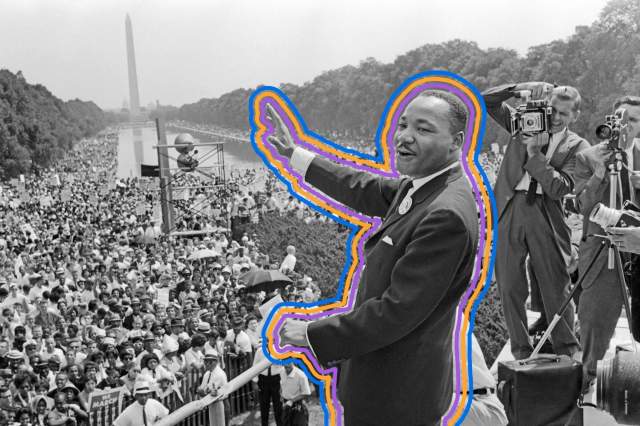
His Birth Name Was Michael
When Martin Luther King Jr. was born on January 15, 1929, his name wasn’t what we know it to be today. According to MLK’s original birth certificate, filed on April 12, 1934, his given name was Michael King Jr. His switch to a new name had to do with his father, who served as senior pastor at Atlanta’s Ebenezer Baptist Church. In 1934, King Sr. traveled to Germany, where he witnessed the budding rise of hate-fueled Nazism throughout the country. Germany was also where, in 1517, theologian and monk Martin Luther wrote his Ninety-Five Theses, which in turn inspired the Protestant Reformation. That movement held great significance to King Sr., who, upon returning to the states, chose the name “Martin Luther” for both himself and his son. MLK Jr. would rise to prominence under this new name, though he didn’t officially amend his birth certificate until July 23, 1957, when the name “Michael” was crossed out and the words “Martin Luther Jr.” were printed next to it.

He Received a “C” at School for Public Speaking
Although he’s known now for being a prolific public speaker, MLK Jr. wasn’t always appreciated for his eloquence. In fact, while attending Crozer Theological Seminary in Chester, Pennsylvania, King received a “Pass,” a “C+,” and a “C” in his public speaking course during the 1948-49 school year. This proved to be an anomaly, though; by the end of King’s time at the seminary, he was a straight-A student, class valedictorian, and student body president. He later attended Boston University, where he got his Ph.D. in systematic theology at the age of 25 in 1955, thus earning the title of doctor.

He Was a Three-Time Grammy Nominee
King was not a musician, but the spoken-word recordings of his most famous speeches earned him several Grammy nominations. The first came in 1964 at the 6th Annual Grammy Awards, where “We Shall Overcome (The March On Washington… August 28, 1963)” was nominated for Best Documentary, Spoken Word, Or Drama Recording (Other Than Comedy). Two other nominations were bestowed upon him posthumously, at the 11th Grammy Awards in 1969 for his recording of “I Have A Dream” (in the Best Spoken Word Recording category), and in that same category for “Why I Oppose the War in Vietnam” at the 13th Grammys in 1971. The latter was his first and only win, but his “I Have A Dream” speech was later voted into the Grammy Hall of Fame in 2012.
More Interesting Reads

London’s Westminster Abbey Features a Statue of MLK
In 1998, a statue honoring Dr. King was unveiled at Westminster Abbey in London, a city where he famously spoke in 1964 while visiting Europe to accept his Nobel Peace Prize. The statue was among a group of 10 of the 20th century’s most celebrated Christian martyrs, which were installed above the Great West Door in niches that had stood vacant for 35 years. Queen Elizabeth II presided over the unveiling, which also honored notable religious figures such as El Salvador’s Archbishop Oscar Romero and Franciscan friar Maximilian Kolbe of Poland. Designed by Tim Crawley, the statues are made of French Richemont limestone and weigh almost a ton each.
Of course, Westminster Abbey is far from the only place to honor King artistically. There are several statues and memorials in the U.S., too, though perhaps none is more prominent than the Stone of Hope, a 30-foot-tall granite statue of King unveiled on D.C.’s National Mall in 2011.

He Was a Huge Fan of “Star Trek”
MLK was not only a huge fan of Star Trek but a pivotal figure in the career trajectory of one of the show’s most beloved actors. Star Trek was the only program King allowed his children to stay up late to watch, in large part because of the character Uhura, played by African American actress Nichelle Nichols. King viewed Nichols’ role as one of the few examples of equality on television — a belief that he expressed to Nichols upon meeting her at a fundraiser for the NAACP. After the show’s first season ended in 1967, Nichols had been leaning toward departing Star Trek for a role on Broadway. In the end, however, she was swayed by King’s passionate words about her power and influence as a role model for Black women, and decided to remain a member of the cast.

King and His Wife Spent Their Honeymoon at a Funeral Parlor
MLK met the woman who would become his wife, Coretta Scott, in Boston in January 1952. They married the next year on June 18, 1953, on Scott’s parents’ lawn in Alabama, though their ensuing honeymoon took an unusual turn. After being denied at several whites-only hotels throughout Marion, a town that held many segregationist beliefs, MLK and his wife were invited by a friend to spend their wedding night in the back room of a funeral parlor. It wasn’t until five years into their marriage that the pair took a more traditional honeymoon trip to Mexico.












